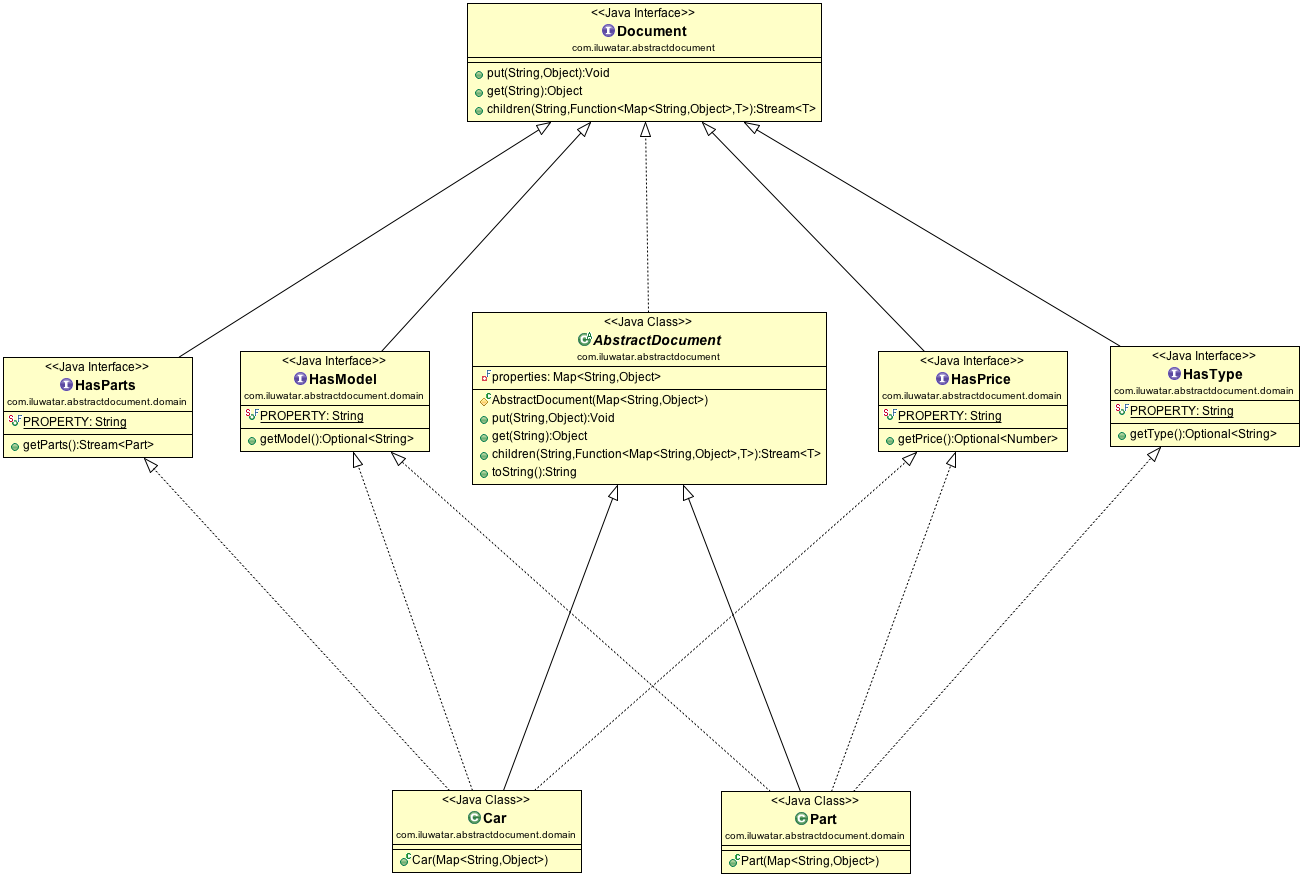Abstract Document
- Structural
Intent
Use dynamic properties and achieve flexibility of untyped languages while keeping type-safety.
Explanation
The Abstract Document pattern enables handling additional, non-static properties. This pattern uses concept of traits to enable type safety and separate properties of different classes into set of interfaces.
Real world example
Consider a car that consists of multiple parts. However we don't know if the specific car really has all the parts, or just some of them. Our cars are dynamic and extremely flexible.
In plain words
Abstract Document pattern allows attaching properties to objects without them knowing about it.
Wikipedia says
An object-oriented structural design pattern for organizing objects in loosely typed key-value stores and exposing the data using typed views. The purpose of the pattern is to achieve a high degree of flexibility between components in a strongly typed language where new properties can be added to the object-tree on the fly, without losing the support of type-safety. The pattern makes use of traits to separate different properties of a class into different interfaces.
Programmatic Example
Let's first define the base classes Document and AbstractDocument. They basically make the object hold a property map and any amount of child objects.
public interface Document {
Void put(String key, Object value);
Object get(String key);
<T> Stream<T> children(String key, Function<Map<String, Object>, T> constructor);
}
public abstract class AbstractDocument implements Document {
private final Map<String, Object> properties;
protected AbstractDocument(Map<String, Object> properties) {
Objects.requireNonNull(properties, "properties map is required");
this.properties = properties;
}
@Override
public Void put(String key, Object value) {
properties.put(key, value);
return null;
}
@Override
public Object get(String key) {
return properties.get(key);
}
@Override
public <T> Stream<T> children(String key, Function<Map<String, Object>, T> constructor) {
return Stream.ofNullable(get(key))
.filter(Objects::nonNull)
.map(el -> (List<Map<String, Object>>) el)
.findAny()
.stream()
.flatMap(Collection::stream)
.map(constructor);
}
...
}
Next we define an enum Property and a set of interfaces for type, price, model and parts. This allows us to create static looking interface to our Car class.
public enum Property {
PARTS, TYPE, PRICE, MODEL
}
public interface HasType extends Document {
default Optional<String> getType() {
return Optional.ofNullable((String) get(Property.TYPE.toString()));
}
}
public interface HasPrice extends Document {
default Optional<Number> getPrice() {
return Optional.ofNullable((Number) get(Property.PRICE.toString()));
}
}
public interface HasModel extends Document {
default Optional<String> getModel() {
return Optional.ofNullable((String) get(Property.MODEL.toString()));
}
}
public interface HasParts extends Document {
default Stream<Part> getParts() {
return children(Property.PARTS.toString(), Part::new);
}
}
Now we are ready to introduce the Car.
public class Car extends AbstractDocument implements HasModel, HasPrice, HasParts {
public Car(Map<String, Object> properties) {
super(properties);
}
}
And finally here's how we construct and use the Car in a full example.
LOGGER.info("Constructing parts and car");
var wheelProperties = Map.of(
Property.TYPE.toString(), "wheel",
Property.MODEL.toString(), "15C",
Property.PRICE.toString(), 100L);
var doorProperties = Map.of(
Property.TYPE.toString(), "door",
Property.MODEL.toString(), "Lambo",
Property.PRICE.toString(), 300L);
var carProperties = Map.of(
Property.MODEL.toString(), "300SL",
Property.PRICE.toString(), 10000L,
Property.PARTS.toString(), List.of(wheelProperties, doorProperties));
var car = new Car(carProperties);
LOGGER.info("Here is our car:");
LOGGER.info("-> model: {}", car.getModel().orElseThrow());
LOGGER.info("-> price: {}", car.getPrice().orElseThrow());
LOGGER.info("-> parts: ");
car.getParts().forEach(p -> LOGGER.info("\t{}/{}/{}",
p.getType().orElse(null),
p.getModel().orElse(null),
p.getPrice().orElse(null))
);
// Constructing parts and car
// Here is our car:
// model: 300SL
// price: 10000
// parts:
// wheel/15C/100
// door/Lambo/300
Class diagram

Applicability
Use the Abstract Document Pattern when
- There is a need to add new properties on the fly
- You want a flexible way to organize domain in tree like structure
- You want more loosely coupled system